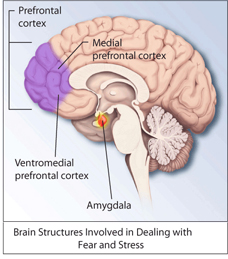|
Anxiety disorders are a group of serious yet treatable disorders
that affect behavior, thoughts, feelings and physical sensations.
Ranging from depression to panic, mood and anxiety disorders are a
leading cause of suffering and impairment. Although they are
widespread, they frequently go undetected and untreated.
What are anxiety disorders?
Normally, anxiety rouses you to action. It gears you up
to face a threatening situation. But if you have an anxiety
disorder, it can do just the opposite - it can keep you from
coping and can disrupt your daily life. Anxiety disorders are not
just a case of "nerves" - they are illnesses. Experts believe that
anxiety disorders are caused by a combination of biological and
environmental factors, much like other disorders such as heart
disease or diabetes.
Types of anxiety disorders
There are several types of anxiety disorders, each with its own
distinct features:
* Generalised anxiety disorder (GAD) is much more than the normal
anxiety people experience day to day. People with GAD suffer from
chronic and exaggerated worry and tension, even though nothing
seems to provoke it. When anxiety becomes hard to control and
persistent (present for more than 6 months), it can have a serious
negative impact on daily activities and general well being
* Specific Phobias: Many people experience specific phobias -
intense, irrational fears of certain things or situations (such as
spiders, dogs, closed-in places or heights). Adults with phobias
realise their fears are irrational, but facing, or even thinking
about facing, the feared object or situation brings on a severe
anxiety or even panic attack
* Social phobia is an intense fear of becoming humiliated in
social situations, specifically of embarrassing yourself in front
of other people. It often runs in families and may be accompanied
by depression or alcoholism. Social phobia often begins around
early adolescence or even younger. Social phobia disrupts normal
life, interfering with career or social relationships
* Panic disorder: People with panic disorder experience frequent,
unprovoked panic attacks that involve symptoms such as a racing
heartbeat, chest pains, dizziness or light-headedness, nausea,
difficulty in breathing and fear of losing control or doing
something embarrassing. Panic disorder is twice as common in women
as in men. It can appear at any age, but most often it begins in
young adults. Untreated, the disorder can become very disabling.
Types
of Anxiety Disorder
• Panic Disorder
• Agoraphobia
• Social Phobia
• Specific Phobia
• Generalized Anxiety Disorder (GAD)
• Limited Symptom Attacks (LSA)
• Obsessive Compulsive Disorder (OCD)
• Post Traumatic Stress Disorder (PTSD)
Treatment of anxiety disorders
The Five Basic Ground Rules Before You Begin
Treatment;-
The first step in getting well
is to stop thinking you're sick, to stop feeding your fears.Stop
talking about it. This includes friends, family and unnecessary
trips to your doctor or therapist.
Stop reading about it and researching it. Many of the long term
anxiety sufferers that I see at one of the clinics have read
everything there is to read on the subject, they are experts in
their field. The net result is nothing. They are still in the
same state of anxiety and in many cases getting worse. Constantly
reminding yourself about your anxiety increases its importance in
your mind and keeps the whole cycle repeating over and over.
Stop thinking about the past problem.
Again, you are reminding yourself of your condition and damaging
your own confidence and self esteem.Start focusing on the future
and getting well.
Fortunately, most people with an anxiety disorder can be helped
with the right professional care. Some people require only a few
months of treatment, while others need a year or more. People with
anxiety disorders often have more than one disorder, which can
complicate treatment. Equally, substance abuse and clinical
depression often co-exist in patients with an anxiety disorder.
Medication can play a useful role in treating anxiety disorders
and may be used in conjunction with other forms of therapy.
Anti-depressant and anti-anxiety medications are often used to
ease symptoms so that other therapy can go forward.
|





